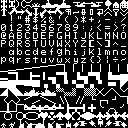A small 6502 system with MS BASIC in ROM. This system includes the following features:
- 32kB SRAM (using one of the four available SPRAM cores)
- 8 bits input, 8 bits output
- 115200bps serial I/O port
- NTSC composite video with 1kB video RAM and 2kB character ROM
- 2kB ROM for startup and I/O support
- 8kB ROM for Ohio Scientific C1P Microsoft BASIC
- 2kB ROM for the video character generator
To build this you will need the following FPGA tools
- Icestorm - ice40 FPGA tools
- Yosys - Synthesis
- Nextpnr - Place and Route
Info on these can be found at http://www.clifford.at/icestorm/
You will also need the following 6502 tools to build the startup ROM:
- cc65 6502 C compiler (for default option) https://github.com/cc65/cc65
git clone https://github.com/emeb/up5k_basic.git
cd up5k_basic
git submodule update --init
cd icestorm
make
I built this system on a custom up5k board and programmed it with a custom USB->SPI board that I built so you will definitely need to tweak the programming target of the Makefile in the icestorm directory to match your own hardware.
You will need to connect a 115200bps serial terminal port to the TX/RX pins of the FPGA (depends on your .pcf definitions - pins 3/4 in my build for the upduino). Load the bitstream an you'll see the boot prompt:
C/W/M?
This is asking if you're doing a cold or warm start. Hit "C" (must be uppercase) and then BASIC will start running. It will prompt you:
MEMORY SIZE?
to which you answer with 'enter' to let it use all memory. It then prompts with:
TERMINAL WIDTH?
Again, hit 'enter' to use the default. It then prints a welcome message and is ready to accept BASIC commands and code. You can find out more about how to use this version of BASIC here: https://www.pcjs.org/docs/c1pjs/
The 2kB ROM located at $f800 - $ffff contains the various reset/interrupt vectors, initialization code and serial I/O routines needed to support BASIC. It's extremely stripped-down and just handles character input, output and Control-C checking - the load and save vectors are currently stubbed out.
You can revise this ROM with your own additional support code, or to reduce the size of the ROM to free up resources for more RAM - you'll need to edit the linker script to change the memory sizes, as well as modify the rom_monitor.s file with code changes. The cc65 assembler and linker are required to put it all together into the final .hex file needed by the FPGA build.
A late addition to the design is a simple NTSC composite video generator which is based on the original Ohio Scientific C1P system. The luma and sync output bits should be combined by running sync thru a 330 ohm resistor and luma thru a 560 ohm resistor to a common node driving a 75 ohm baseband composite video load. This will generate a 262-line 60fps progressive-scanned NTSC-compatible signal which should work with most modern NTSC-capable video displays.
The video generation has been upgraded from the OSI 24x24 display to support 32 characters wide by 27 lines high plus overscan and uses the original OSI character generator, complete with all the unique gaming glyphs like tanks, cars and spaceships as shown in this rendering:
Simulation is supported and requires the following prerequisites:
- Icarus Verilog simulator http://iverilog.icarus.com/
- GTKWave waveform viewer http://gtkwave.sourceforge.net/
To simulate, use the following commands
cd icarus
make
make wave
This will build the simulation executable, run it and then view the output.
There have been questions raised about the copyright status of the MS BASIC provided in this project. To the best of my knowledge, the contents of the file src/basic_8k.hex is still property of Microsoft and is used here for educational purposes only. The full source code for this can be found at:
https://github.com/brajeshwar/Microsoft-BASIC-for-6502-Original-Source-Code-1978
The ROM files from which I created the .hex file are also available in many places - I used this archive: http://www.osiweb.org/misc/OSI600_RAM_ROM.zip
Thanks to the developers of all the tools used for this, as well as the authors of the IP cores I snagged for the 6502 and UART. I've added those as submodules so you'll know where to get them and who to give credit to.

